Targeted and tested
Editor’s note: Dan Murphy is vice president of Insights Marketing Group, a Winston-Salem, N.C., research firm.
Why do you have a multicultural ad budget? To fend off political activists? Because “it’s the right thing to do”? How committed is your company to multicultural advertising? Is the media budget underfunded? When times get tough, is the multicultural budget the first to get cut? Who tells you whether your multicultural advertising is any good - whether it is engaging or offending its target audience? Your multicultural agency? Your multicultural employees?
This article identifies the right business reasons for implementing and committing to multicultural advertising campaigns. It details with normative copytesting data why and how targeted multicultural advertising has the inherent potential to be more effective than general-market advertising. It also details how you can be assured that your multicultural advertising is effective, culturally sensitive and relevant through the use of a consumer feedback protocol specially designed to assess not only the performance dimensions of advertising in general but also the dimension of cultural sensitivity that is unique to multicultural advertising.
There are several legitimate reasons for advertisers to consider targeted multicultural advertising. The 2000 census documented the number and importance of ethnic consumers within the U. S. population. Today ethnic subcultures are more likely to maintain their distinctive mores such that America is no longer a melting pot but an ethnically diverse “salad bowl” of distinctive cultural values, norms and behaviors. Ethnic consumers often exhibit different usage patterns and/or attitudes toward products or services versus the mainstream, another viable rationale for targeted multicultural advertising. Many marketers consider multicultural advertising for its PR value. These marketers reflect the real-world cultural diversity within their advertising and/or utilize multicultural media within their media mix because, as good corporate citizens, it is the right thing to do or, more cynically, to preempt or react to boycotts and any other unfavorable action promulgated by political activists.
Yet the best reason to utilize targeted multicultural advertising is to capitalize on its inherent greater effectiveness versus general-market advertising that is merely adapted to the ethnic market. The fact that targeted multicultural advertising is, indeed, inherently more effective may be surprising to some marketers. However, this conclusion can be supported both theoretically as well as empirically.
Distinctiveness theory denotes that “a person’s distinctive traits in relation to other people in the environment will be more salient to the person than more common traits” (McGuire 1984; Grier & Deshpande 2001). Speech accommodation theory postulates that communicators can improve communication by making themselves more similar to the receivers of their message (Giles, Coupland and Coupland 1991). These theories suggest that targeted multicultural advertising will not only reach more of the target audience due to its greater saliency but that the quality of message registration will also be enhanced. Moreover, there are practical considerations that underlie ethnic subcultures’ heightened receptivity to advertising, in general, and targeted advertising, in particular. First, while brand selections for most basic products are established within mainstream cultures, they are more frequently reevaluated within ethnic subcultures, whose members use advertising to aid in determining how to best satisfy product/service requirements within more limited budget constraints. Moreover, ethnic subcultures have greater trust in/dependence on brands, especially premium brands, often utilizing them as a badge to establish their status in a society that sees them as second-class. Finally, for unacculturated immigrant subcultures, advertising is an important source of information about products and services that are new to their lives.
Empirical evidence also supports the notion that targeted multicultural advertising outperforms general-market advertising. Through our license with Diagnostic Research to conduct multicultural copytesting, we analyzed their historical database. In comparing the performance of the average of 15 general-market TV motor vehicle ads which were adapted to the African-American market through the use of integrated or African-American casting to 52 African-American-targeted ads tested among African-American respondents, it is evident that multicultural advertising generally scores higher than general-market advertising in each of the four critical areas of advertising performance: impact - the degree to which the ad stands out in clutter; comprehension - the degree to which the desired message is clear, credible and compelling; appeal - the likeability of the ad and its key elements; motivation - the degree to which the advertising establishes positive attitudes toward the advertiser and moves the viewer toward buying behavior. The following will detail results of the Diagnostic Research copytest data. We use the term “converted” to describe the general-market advertisements that were adapted for the African-American market through casting, and “targeted” to describe advertisements created in-culture for the African-American market.
Impact/brand registration (Figure 1): Impact, measured by unaided recall of the test ad in the first three mentions after exposure to the ad in the fourth (middle) position of an exposure to seven commercials, and brand registration, measured by total unaided recall of the test ad after the clutter, are somewhat enhanced for targeted African-American advertising relative to converted general-market advertising.
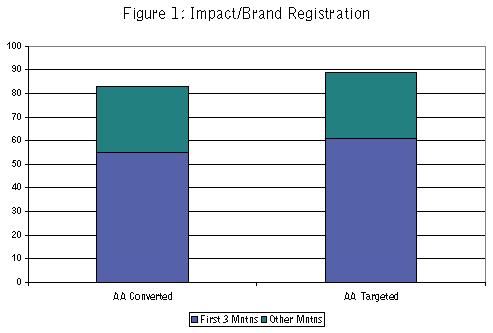
Comprehension (Figures 2-5): While product messages are less likely to be played back in targeted versus converted ads, those messages are comparable in importance, uniqueness and clarity and are more credible in targeted advertising.
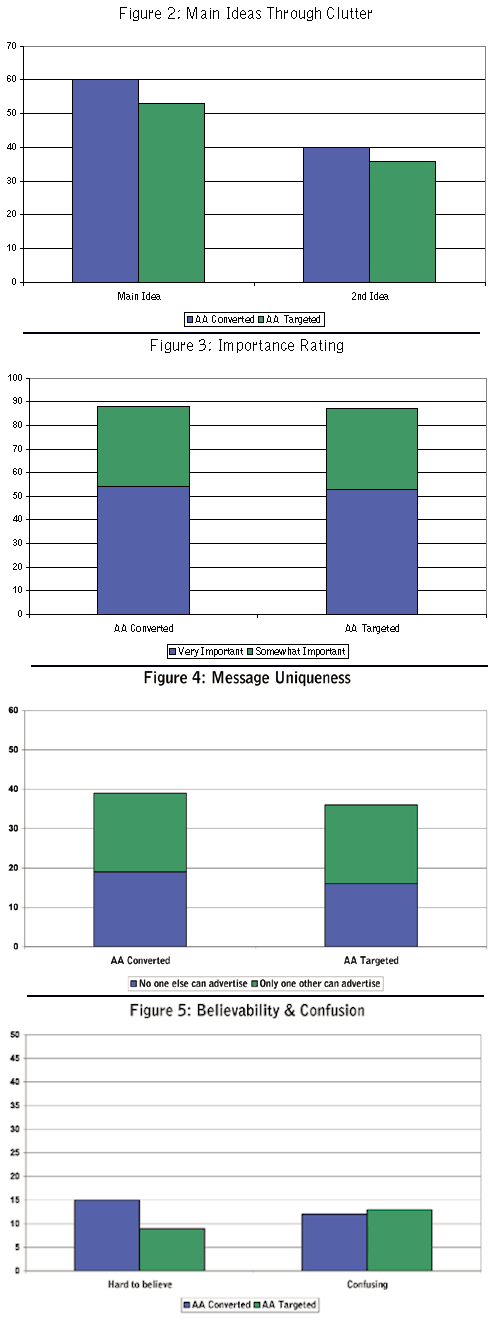
Appeal (Figures 6-7): As one might expect, African-American audiences are more attracted to how the message is presented in targeted versus converted ads since targeted ads generally contain cues and symbols unique to African-American culture. Their greater focus on presentation elements in targeted ads explains their lower playback of product sales messages noted above. Overall, targeted ads are more appealing to African-Americans than converted general-market ads.
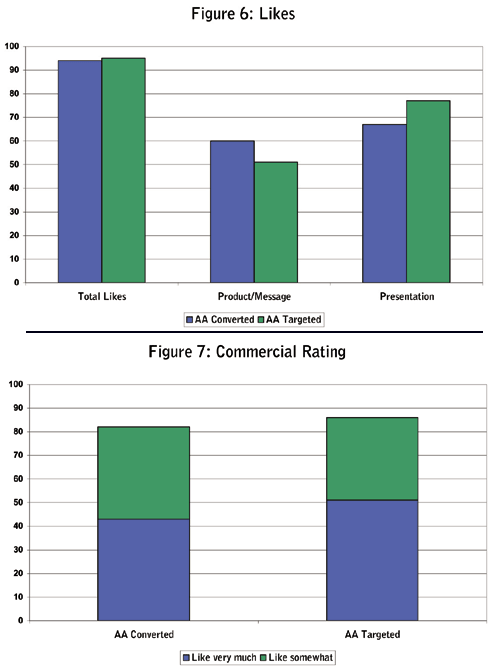
Motivation (Figures 8-10): African-American audiences rate brands in targeted advertising more favorably and appear to be more motivated to action by targeted advertising than converted general-market ads.
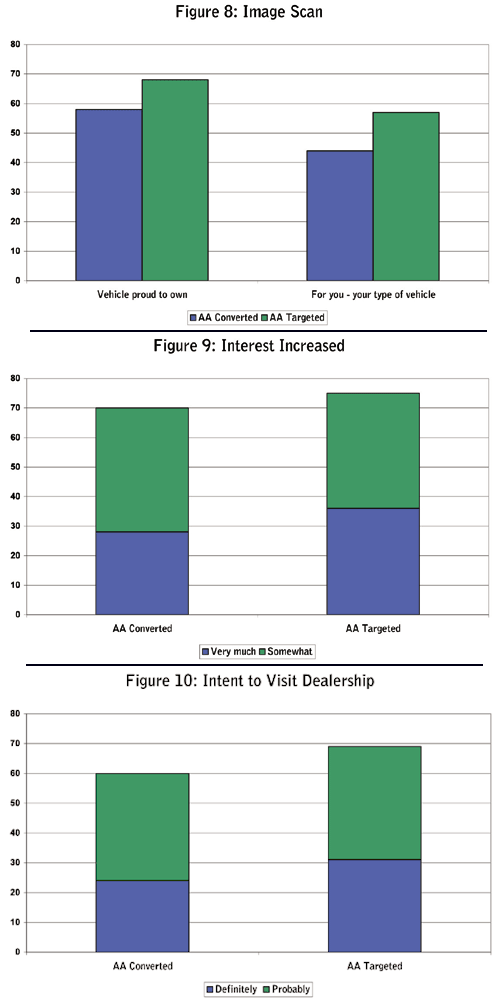
While both theoretical and empirical evidence indicates that targeted multicultural advertising has the potential to be more effective than converted general-market advertising against its target audience, that potential inherent strength is not always realized. In developing multicultural advertising, advertisers are advised to follow the same discipline utilized in the development of general-market advertising. They must have full knowledge of their target and their target’s relationship with their brand. They must know their own product/service and what separates it from its competitors. Out of this knowledge, they can then craft a selling message and deliver it in advertising that is 1) impactful, 2) communicates in a compelling, clear, believable manner, 3) is appealing and 4) is persuasive.
Another dimension
Beyond these four considerations, creatives must recognize that there is a fifth performance dimension for multicultural advertising: cultural relevance. Cultural relevance relates to the degree and quality of cultural accommodation within targeted advertising such that the target audience recognizes that the advertising is uniquely about them. Cultural relevance is what separates multicultural from general-market advertising and is the key that unlocks the potential enhanced efficacy of multicultural advertising. As indicated above, subculture consumers respond more favorably to communication that accommodates the distinctive traits of the specific subculture. Presumably the greater the degree of accommodation, the more effective the advertising will be. Perhaps a useful way for marketers to come to grips with the issue of accommodation is to envision multicultural advertising within a two-dimensional matrix like the one shown in Figure 11. The first dimension delineates the degree of accommodation while the second dimension delineates the quality of the accommodation.
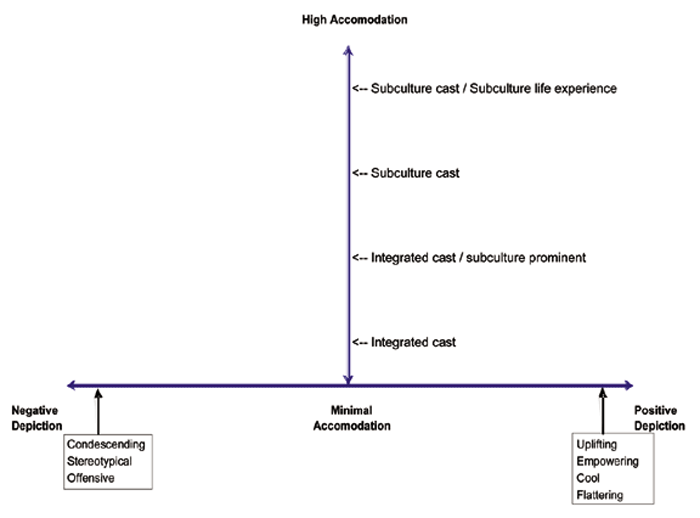
The degree of accommodation dimension ranges from low to high based on the degree to which the target audience’s distinctive identity/culture is evident. For example, in targeting African-Americans, the low end of the spectrum would include ads that merely integrate African-Americans into the cast of an existing general-market ad. Higher on this spectrum would be advertising that integrates African-Americans in a prominent position in the cast. Higher still would be the conversion of a general-market ad to an all-African-American cast. Highest on this dimension would be advertising that not only utilizes an African-American cast but also depicts unique aspects of the African-American culture relevant to the specific African-American target. This dimension reflects the degree to which the advertising authentically captures the subculture’s life experiences.
The quality of accommodation dimension ranges from positive to negative. The range reflects the degree to which the subculture is perceived to be depicted in a positive or negative light. Positive depiction might be described as uplifting, empowering, cool or flattering while negative depiction might be described as stereotypical, condescending or even offensive. Note that the effectiveness of advertising that is positioned high on the degree of distinctiveness dimension can be undermined by poor performance on the quality of distinctiveness dimension.
Hypothetically, the most effective targeted advertising is that which is positioned highly on both the degree and quality of accommodation dimensions.
While the above theoretical construct can be helpful in thinking about the task of developing multicultural advertising, there is no formula to follow that will yield optimal advertising. Every situation is different, consisting of a unique product/service as well as a unique target distinguished by its specific relationship with the product/service, demographics/psychographics, degree of acculturation, strength of ethnic identity, etc.
To be assured that any specific multicultural ad is optimally effective, you must obtain comprehensive relevant consumer feedback on the performance of the ad within the target audience. The ideal consumer feedback protocol should include an in-depth assessment of the ad’s performance on the four basic dimensions of impact/brand name registration, comprehension, appeal and motivation, as well as the critical fifth dimension of cultural relevance. Results of the testing should be benchmarked against norms that account for the inherent strength of multicultural advertising - not general-market advertising norms. In addition, the results should ideally be analyzed by researchers who are experienced with and sensitive to multicultural communication issues. The end result of this target consumer feedback protocol is informed decision-making with respect to whether airing the advertising is warranted as well as direction for refinements/ revisions to the advertising.
Enhanced potential
In sum, the case for multicultural advertising is based on enhanced business potential associated with an inherent potential for more effective performance of the advertising. This more effective performance is achieved through a disciplined approach to creative development that recognizes the power of cultural relevance for multicultural audiences. The more effective performance is assured through a comprehensive consumer testing protocol that measures the basic ad performance dimensions plus the key dimension of cultural relevance. The end result is good multicultural advertising and more business.
